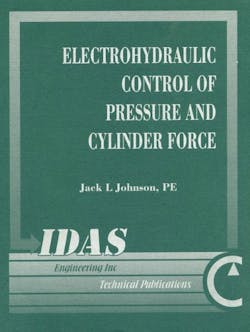The hydromechanical resonant frequency (HRF) of a valve-cylinder circuit is an interesting concept and an important value to know. If a cylinder is stroking, and its control valve suddenly shifts to block flow, the cylinder and its load will vibrate, usually with considerable noise and sometimes with considerable violence. This is HRF in action. The noise arises from the resonance that exists when the kinetic energy of the load mass and the potential energy stored in the hydraulic fluid’s compressibility are exchanged.
We can estimate the HRF for a given circuit using this formula:
HRF = (1/π) × (Aß ÷ MLs)1/2
where:
A is the average wetted area of the two sides of the piston,
ß is the fluid compressibility factor or bulk modulus,
M is the effective mass acting at the end of the cylinder rod, and
Ls is the cylinder’s effective stroke length.
This formula is a valid approximation for most industrial cylinders provided the valve-to-cylinder plumbing is small. All these factors can be obtained at design time or during assembly of the circuit. Therefore, we can calculate the HRF with reasonable accuracy. Its value is crucial to the smooth, reliable operation of any hydraulic circuit, so HRF should be calculated as a routine part of any design procedure.
Additional importance lies in the fact that HRF establishes the maximum rate at which a hydromechanical system can be cycled. Cycle rate dictates manufacturing productivity, and productivity determines product cost. The competitive posture of a manufacturing process is tied directly to the rate at which production machinery can be cycled! Thus, it is essential to know the HRF of every hydraulic machine.
A rule of thumb used by motion-control designers is that the maximum machine cycle rate is about equal to the product of two-thirds the HRF and the system damping ratio (SDR). System damping ratio is born of friction, and after years spent removing friction from cylinders and load bearings, it is not uncommon to find SDRs as low as 0.03 today. Add to that the fact that the quest for higher operating pressures to reduce component size always leads to lower resonant frequency (by decreasing area A), and the result is a trend in the industry that actually makes high cycle-rate machines more difficult to design instead of easier!
For example, if the HRF is 10 Hz (the majority of systems have an HRF between 10 and 60 Hz) and the SDR is 0.03, then the maximum attainable machine cycle rate is no faster than 0.2 Hz, or one cycle every five seconds, which is no more than 12 cycles per minute. Any faster and objectionable or damaging shock and vibration begin. And that calculation will hold only if the acceleration is controlled, as can only be done with servo or proportional valves. Discrete (bang-bang) valves simply won’t work unless they are specified with a soft-shift option.
Knowing HRF leads to success
Many failed hydraulic applications arise because the designer attempts to cycle the machine faster than its resonant frequency will allow. Electrical machines have replaced many of these hydraulic machines, but they need not have. Electrical machines were successful because system designers calculated all the system frequencies, understood the implications, and then designed within those limitations.
Think of HRF as a kind of hydraulic speed of light — beyond which we cannot go. In fact, we can only approach it in designs with sufficient safety margin. It is essential to the continued success of hydraulic technology that we calculate the hydromechanical resonant frequency in all our systems.
Handbook introduces cylinder control
The textbook contains 220 pages and sells for $59.95. To order, visit our Bookstore. Print the PDF order form, fill it out, and mail, fax, or e-mail it to us.


